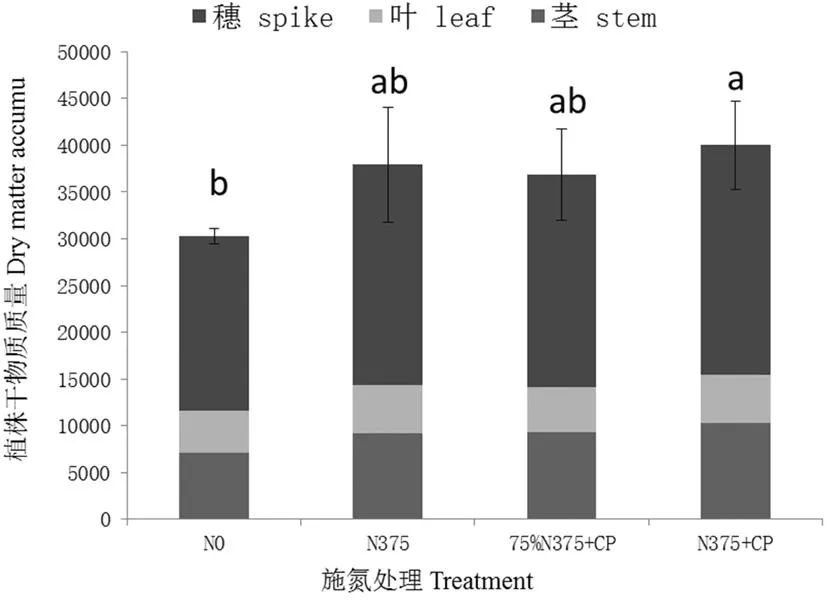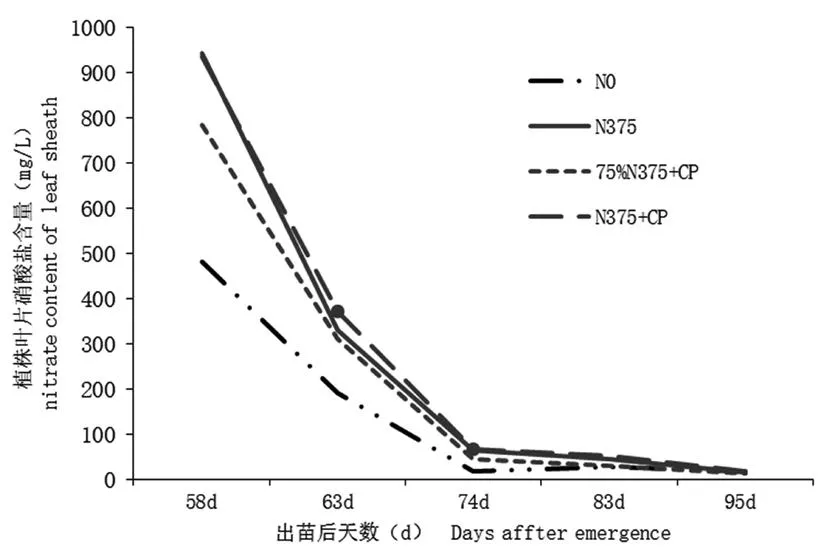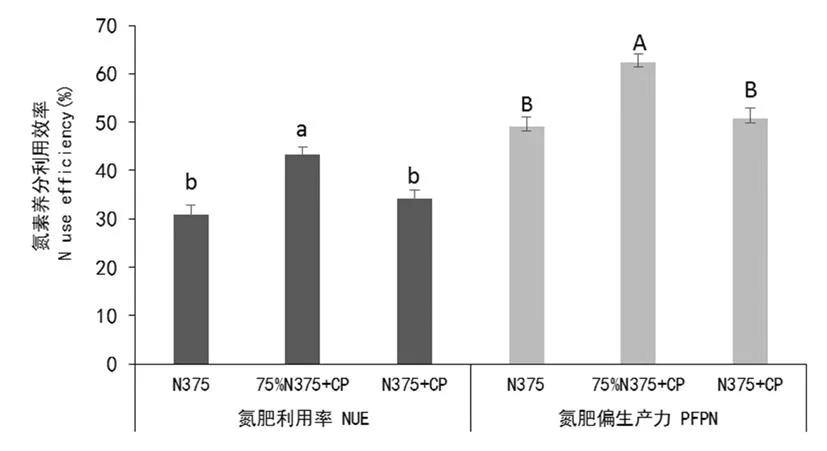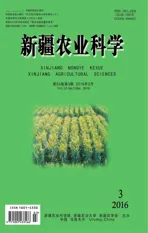减氮增铵对滴灌玉米氮素营养及产量的影响
2016-05-12王雪薇夏文豪褚贵新
王雪薇 ,夏文豪, 刘 涛, 唐 诚, 褚贵新
(新疆生产建设兵团绿洲生态农业重点实验室/石河子大学农学院,新疆石河子 832000)
减氮增铵对滴灌玉米氮素营养及产量的影响
王雪薇 ,夏文豪, 刘 涛, 唐 诚, 褚贵新
(新疆生产建设兵团绿洲生态农业重点实验室/石河子大学农学院,新疆石河子 832000)
摘要:【目的】增铵营养具有明显改善旱地作物氮素营养与提高作物产量的效应。【方法】设置N(0 )(不施氮)、N(375 )(全氮)、75%N(375)+CP (减氮25%+增铵)以及N(375)+CP (全氮增铵)4个处理,在覆膜滴灌条件下,研究尿素减量及其与氯甲基吡啶,随水分次滴施对玉米氮素营养、产量及氮素养分资源利用效率的影响。【结果】减氮增铵处理75%N(375)+CP可促进植株干物质的积累,较N0增加了22%;75%N(375)+CP处理的玉米叶鞘含量比N(375)处理降低了16.7%;75%N(375)+CP处理产量较N0处理增加了18.6%,且使滴灌玉米的氮素利用效率和氮肥偏生产力,较全氮施肥分别提高了41.6%和26.8%。【结论】在滴灌水氮一体化供应条件下,通过硝化抑制剂增铵减少氮肥用量25%(75~95 N kg/hm2),可显著提高氮素养分利用效率。
关键词:玉米;籽粒产量;减氮增铵;氮素利用率;氮素营养
0引 言

1材料与方法
1.1材 料
该试验为滴灌小区试验,于2014年在新疆沙湾县乌兰乌苏气象站试验地进行(E85°49′、N44°17′),年降雨量约为187.7 mm,供试土壤为灌耕灰漠土(CalcaricFluvisal),质地为壤土,耕层(0~20 cm),土壤pH 8.52,有机质18.73 g/kg,全氮0.96 g/kg,速效磷23.87 g/kg,速效钾340.95 g/kg。玉米品种为春玉米良玉66 号。供试氮肥为尿素(含N 46.6%)375 kg/hm2、磷肥为磷酸一铵(含P2O561%、含N 12%)90 kg /hm2,钾肥为硫酸钾(含K2O 51%)90 kg/hm2。
1.2 方 法
1.2.1试验设计
采用滴灌小区试验,随机区组设计。设置4个处理,分别为:T1:N0(CK)、T2:N375(当地滴灌高产玉米常规施氮量)、T3:75%N375+CP、T4:N375+CP(其中N375:纯氮施量375 kg/hm2,75%N375:纯氮施量281.25 kg/hm2,CP:氯甲基吡啶 上海碧晶),重复3次。40+80 (cm)宽窄行覆膜种植,株距14.5 cm,每小区4膜,1膜2行,铺设1条滴灌带,理论种植密度为112 500株/hm2,小区面积38.4 m2(4.8 m×8.0 m)。氮肥和磷肥全部作追肥随水滴施,生育期内滴水10次,施肥8次,各生育时期田间管理措施等同当地一般大田。4月25日播种至10月2日收获。表1
表1具体滴水施肥方案
Table 1 Schedule for water drip irrigation and fertigation of both N and P fertilizers

出苗后天数TheDaysafterseedlingemergence(d)506068758290100110120135滴水量(%)Irrigationvolume15101510101010884N (%)15101512151210650P2O5(%)78101112131313130
1.2.2样品采集及测定项目1.2.2.1植物干物质量及养分含量
分别在玉米拔节期、抽雄吐丝期、灌浆期、乳熟期、完熟期滴水施肥前取植株样,各小区随机取3株,分器官在105℃杀青30 min,然后在75℃烘干恒重,称重,测定干物质量;粉碎样品测定植株氮含量及氮素吸收量。
1.2.2.2 植物中硝酸盐含量
用RQ flex10反射仪(德国MERCK)测定玉米叶鞘的硝态氮含量。测试时期为拔节期、抽雄吐丝期、灌浆期。拔节期测定最上部完全展开叶的叶鞘部位,抽雄吐丝期和灌浆期测定穗位叶的叶鞘部位,各小区随机抽取无损伤且长势均匀的 3株进行测定。
1.2.2.3产量与产量构成要素
测产:在每个小区未取样区划2.4 m×4.0 m的样方,收获全部玉米,称重并计算穗数。
考种:每个小区随机取20株长势相似的玉米,进行考种,测定产量构成要素及相关指标,计算产量。
氮肥偏生产力=施氮区玉米产量/施氮量;
氮肥利用率=(施氮区玉米地上部吸氮量-无氮区玉米地上部吸氮量)/施氮量×100%[12]。
1.3数据统计
采用Excel软件进行数据的统计分析;用SPSS17.0软件对数据进行单因素方差分析。
2 结果与分析
2.1不同施氮处理对植株干物质量的影响
研究表明,不同处理对玉米各个器官干物质积累有较大影响。完熟期玉米干物质的分配表现为:穗部(61.4%~62.1%)>茎秆(23.4%~25.8%)>叶片(12.7%~15.0%)。与对照处理(N0)相比,施氮可增加玉米茎、叶、穗干物质量(P< 0.05);N375、75%N375+CP和N375+CP处理的干物质分别比N0增加了7 648.8、6 565.1、9 732.0 kg/hm2,增幅分别为25%、22%、32%。各施氮处理之间的干物质量表现为N375+CP > N375> 75%N375+CP。N375和N375+CP处理的干物质分别比75%N375+CP处理增加了1 083.7和3 166.85 kg/hm2,增幅分别为2.9%和8.6%,但经方差分析处理间差异不显著。由此可见,减氮增铵不会显著降低玉米干物质积累量。图1

图1不同施氮处理下玉米成熟期干物质量变化
Fig. 1 The effect of different N treatments on maize dry matter accumulation at maturity stage
2.2不同施氮处理对叶片硝酸盐含量的影响



2.3不同施氮处理对叶片含氮量和吸氮量的影响
研究表明,拔节期施氮处理植株叶片含氮量均显著(P< 0.05)高于不施氮处理N0。N375+CP、N375和75%N375+CP处理叶片含氮量分别较N0处理增加了38.8%、32.9%、43.9%,差异显著(P< 0.05),但3个施氮处理间差异不显著。在拔节期和成熟期各施氮处理玉米植株吸氮量均显著高于对照(P< 0.05)。如在拔节期,N375、75%N375+CP和N375+CP处理的叶片含氮量分别比对照增高了54.6%、44.3%和76.5%;在成熟期时N375、75%N375+CP和N375+CP处理的叶片含氮量分别比对照增高了60.7%、46.9%和67.5%;但施氮处理间植株叶片吸氮量不显著。说明减氮增铵处理并不会降低植株叶片含氮量、吸氮量。表2
表2 不同施氮处理下叶片含氮量和吸氮量变化
Table 2 The effects of different N treatment on leaf total N content and maize N uptake

处理Treatment植株叶片含氮量LeafNtotalcontent(g/kg)拔节期Jointingstage成熟期Maturestage 植株叶片吸氮量MaizeNuptake(kg/hm2)拔节期Jointingstage成熟期MaturestageN014.48±2.44b10.84±1.37a48.75±6.73b53.44±7.14bN37520.10±1.75a12.90±0.65a75.40±4.60a85.92±2.81a75%N375+CP19.25±2.13a12.13±1.06a70.35±5.74a78.54±14.73aN375+CP20.84±0.77a13.03±1.79a86.08±18.60a89.52±10.53a平均Mean18.6712.22 70.1476.86
注:同一列中不同字母表示差异达到显著水平(P<0.05),下同
Note:Different letters on the same column mean significant difference atP<0.05,the same as below
2.4不同施氮处理对玉米产量与构成要素影响
研究表明,从玉米产量构成要素分析,千粒重各处理之间差异不显著,施氮处理对玉米千粒重无显著影响。从产量分析,与对照(N0)相比,施氮可以显著提高玉米产量。75%N375+CP、N375、N375+CP处理玉米产量分别较N0处理增加了18.6%、24.4%和28.9%。虽然75%N375+CP处理的玉米产量在3个施肥处理中最低,但经统计各施氮处理间差异未达到显著水平;说明减氮增铵并不会降低滴灌玉米产量。表3
表3不同施氮处理下玉米产量与构成要素
Table 3The effect of different N treatment on maize yield and its component

处理Treatment产量及其构成因素Theyieldanditscomponents产量(kg/hm2)Grainyield穗数(株/hm2)Spikes穗粒数Grainsperear千粒重(g)1000-seedweightN014787±451b100312594±10c433±31aN37518405±446a100660648±25ab432±3a75%N375+CP17542±766a100747623±37bc454±4aN375+CP19063±295a100225677±9a456±48a
2.5不同施氮处理对滴灌玉米氮肥利用效率的影响
研究表明,滴灌玉米的氮肥利用率在39.0%~44.6%,不同施肥处理间氮肥利用率顺序表现为75%N375+CP>N375+CP>N375。75%N375+CP的氮肥利用效率分别较N375和N375+CP处理提高了41.6%和27.4%,且差异显著(P<0.05)。氮肥偏生产力变化范围为47.1%~64.0%,3个施氮处理的氮肥偏生产力与氮肥利用率呈相同趋势。75%N375+CP的氮肥偏生产力也表现为最高,分别较N375和N375+CP处理提高了26.8%和22.8%,且三者差异显著(P<0.05)。说明在滴灌条件下通过减氮增铵可显著提高滴灌玉米氮素养分利用效率。图3

图3不同施氮处理下玉米氮肥利用率及氮肥偏生产力变化
Fig. 3 The effect of different N treatment on maize apparent N fertilizer recovery rate and partially fertilizer production per N of nitrogen fertilizer
3 讨 论

4 结 论
在天山北坡滴灌玉米种植区,以当地滴灌高产玉米施氮量(375 kg/hm2)为基础,通过减氮增铵(75%N375+CP)可促进植株干物质的积累,且可改善植株氮素营养,提高玉米植株吸氮量;减肥增铵处理的玉米氮素利用效率和氮肥偏生产力,较全氮施肥提高了41%和26.8%。在现有常规施肥量的情况下,通过增铵措施、氮肥施量减少25%并不会导致减产。在滴灌水氮一体化条件下,通过硝化抑制剂增铵减少氮肥用量25%(75~95 N kg/hm2)不仅不会降低玉米的氮素营养与产量,且可显著提高氮素养分利用效率。
参考文献(References)
[1]吴美玲. 减施氮对不同品种玉米产量和氮效率的影响研究[D]. 长春:吉林农业大学硕士论文, 2014.
WU Mei-ling. (2014).Researchoneffectofreducingnitrogenonyieldandnitrogenefficiencyofdifferentvarietiesofmaize[D]. Master Dissertation. Jilin Agricultural University, Changchun. (in Chinese)
[2] 吴建新, 左强, 王甲辰, 等. 不同施肥措施对球茎茴香产量、品质及氮平衡的影响[J]. 北方园艺, 2010, (10): 15- 18.
WU Jian-xin, ZUO Qiang, WANG Jia-chen, et al. (2010). Effects of different fertilization treatments on yield, quality and nitrogen balance of the bulb [J].NorthernHorticulture, (10): 15-18. (in Chinese)
[3] 马群, 李国业, 顾海永, 等. 我国水稻氮肥利用现状及对策[J].广东农业科学, 2010, 37(11):126-129.
MA Qun, LI Guo-ye, GU Hai-yong, et al. (2011). Current situation and Countermeasures of rice nitrogen fertilizer use in China [J].XinjiangAgriculturalSciences, 37(11):126-129. (in Chinese)
[4] 刘建亮. 旱地高产高效玉米栽培体系水氮管理及调控[D]. 杨凌:西北农林科技大学博士论文, 2014.
LIU Jian-liang. (2014).Managementandregulationofwaterandnitrogenforhigh-yieldandhigh-efficiencydrylandmaizesystem[D]. PhD Dissertation. Northwest Agriculture and Forestry University, Yangling. (in Chinese)
[5] Pang, X. P., Gupta, S. C., Moncrief, J. F., Rosen, C. J., & Cheng, H. H. (1998). Evaluation of nitrate leaching potential in minnesota glacial outwash soils using the ceres-maize model.JournalofEnvironmentalQuality, 27(1):75-85.
[6] 谭贺. 不同氮肥运筹对春玉米干物质积累及氮吸收分配的影响[D]. 长春: 东北农业大学硕士论文, 2013.
TAN He. (2013).EffectsofDifferenceNitrogenManagementsonDryMatterAccumulation,NitrogenUptakeandDistributionofSpringMaize[D]. Master Dissertation. Northeast Agricultural University, Changchun. (in Chinese)
[7] 王秀斌, 徐新朋, 孙刚, 等. 氮肥用量对双季稻产量和氮肥利用率的影响[J]. 植物营养与肥料学报, 2013,(6):1 279- 1 286.
WANG Xiu-bin, XÜ Xin-ming, SUN Gang, et al. (2013). Effects of nitrogen fertilization on grain yield and nitrogen use efficiency of double cropping rice [J].PlantNutritionandFertilizerScience, (6):1,279-1,286. (in Chinese)
[8] 姜雯, 周登博, 张洪生,等.不同施肥水平下聚天冬氨酸对玉米幼苗生长的影响[J]. 玉米科学, 2007, 15(5):121- 124.
JIANG Wen, ZHOU Deng-bo, ZHANG Hong-sheng, et al. (2007). The Effect of Poly aspartic Acid on Maize Growth at Seedling Stage Under Different Fertilizer Applied Condition [J].JournalofMaizeScience, 15(5):121-124. (in Chinese)
[9] 孙传范, 戴廷波, 曹卫星. 不同施氮水平下增铵营养对小麦生长和氮素利用的影响[J]. 植物营养与肥料学报, 2003, (1):33-38,49.
SUN Chuan-fan, DAI Ting-bo, CAO Wei-xing. (2003). Effect of the Enhanced Ammonium Nutrition on the growth and nitrogen utilization of wheat under different N levels [J].PlantNutritionandFertilizerScience, (1):33-38,49. (in Chinese)
[10] 张维理, 田哲旭, 张宁,等. 我国北方农用氮肥造成地下水硝酸盐污染的调查[J]. 植物营养与肥料学报, 1995, 1(2) : 80 - 87.
ZANG Wei-li, TIAN Zhe-xu, ZHANG Ning, et al. (1995). Investigation of nitrate pollution in ground water due o nitrogen fertilization in agriculture in north China [J].PlantNutritionandFertilizerScience, 1(2): 80 -87. (in Chinese)
[11] Liu, L. J., Sang, D. Z., Liu, C. L., Wang, Z. Q., Yang, J. C., & Zhu, Q. S. (2004). Effects of real-time and site-specific nitrogen managements on rice yield and nitrogen use efficiency.AgriculturalSciencesinChina,(4):262-268.
[12] 王端, 纪德智, 马琳,等. 春玉米产量和施氮量对氮素利用率的影响[J]. 中国土壤与肥料, 2013, (6):42- 46.
WANG Rui, JI De-zhi, MA Lin, et al. (2013). Effects of corn yield and nitrogen application on nitrogen use efficiency [J].SoilandFertilizerinChina, (6):42- 46. (in Chinese)
[13] 戴廷波,曹卫星,孙传范,等. 增铵营养对小麦光合作用及硝酸还原酶和谷氨酰胺合成酶的影响[J]. 应用生态学报,2003, 14(9):1 529-1 532.
DAI Ting-bo, CAO Wei-xing, SUN Chuan-fan, et al. (2003). Effect of enhanced ammonium nutrition on photosynthesis and nitrate reuctase and glutamine syntheses activities of winter wheat [J].ChineseJournalofAppliedEcology,14(9): 1,529-1,532. (in Chinese)
[14] 李彩凤. 增铵营养对玉米品质影响初探[J]. 玉米科学,2003,11(3):82-84.
LI Cai-feng. (2003). Primarily Research on Quality of Maize Influenced by Enhanced Ammonium Nutrition [J].JournalofMaizeSciences, 11(3): 82-84. (in Chinese)
[15] 孙传范, 戴廷波, 荆奇,等. 不同生育时期增铵营养对小麦生长及氮素利用的影响[J]. 应用生态学报, 2004, 15(5):753- 757.
SUN Chuan-fan, DAI Ting-bo, JING Qi, et al. (2004). Effect of enhanced ammonium nutrition(EAN)at different growth stages on wheat growth and nitrogen utilization [J].ChineseJournalofAppliedEcology, 15(5): 753- 757. (in Chinese)
[16] 田秀英, 王正银. 尿素与复合氮肥增效剂配施对水稻氮素利用的影响[J]. 水土保持学报,2006, 20(6):120- 123.
TIAN XU-ying, WANG Zheng-yin. (2006). Effect of Urea Combined with Compound Nitrogen Fertilizer Synergists on Nitrogen Utilization of Rice [J].JournalofSoilandWaterConservation, 20(6): 120-123. (in Chinese)
Response of Reduing Nitrogen and Enhancing Ammonium to Maize N Nutrition and Yield under Drip Irrigation Condition
WANG Xue-wei, XIA Wen-hao, LIU Tao, TANG Cheng, CHU Gui-xin
(KeyLaboratoryofOasisEco-agricultureofXinjiangProductionandConstructionCorps/CollegeofAgronomy,ShiheziUniversity,ShiheziXinjiang832003,China)
Abstract:【Objective】 The project aims to study the effect of enhancing ammonium nutrition in upland crop nitrogen nutrition in arid areas and improve crop yield as well. 【Method】In the present study, the effect of decreasing urea supply rate and enhancing ammonium nutrition by chloromethyl pyridine on maize yield, corn plant N nutrition status and N fertilizer using efficiency were investigated under plastic mulched drip irrigation condition. Four treatments was designed: N0 (without N), N(375 )(375 kg/hm2), 75%N(375)+CP (25% of N was reduced plus chloromethyl pyridine) and N(375)+CP (375 kg/hm2 plus chloromethyl pyridine). 【Result】Plant dry matter accumulation was increased by 22% with 75%N(375)+CP treatment compared with N0; the leaf -N content of maize was decreased by 16.7% with 75%N(375)+CP treatment in contrast to N(375); the maize yield was increased by 18.6% with 75%N(375 )+ CP treatment compared with N0, and N fertilizer recovery rate and nitrogen partial factor productivity of maize was increased by 41% and 26.8% respectively, in 75%N(375)+CP treatment compared with N0. 【Conclusion】 In brief, a great fertilizer N recovery rate and better plant N status could be archived by corn, meanwhile, the maize yield is not down through the strategy of reducing N supply rate and enhancing ammonium nutrition under drip irrigation condition.
Key words:maize; grain yield; decreasing the nitrogen and increasing the ammonium; nitrogen fertilizer use efficiency; maize N nutrition
中图分类号:S513;S14
文献标识码:A
文章编号:1001-4330(2016)03-0461-06
作者简介:王雪薇(1993-),女,新疆人,硕士研究生,研究方向为植物营养,(E-mail)grammays17@163.com通讯作者:褚贵新(1969-),男,甘肃人,教授,博士生导师,研究方向为植物营养生理生态与新型肥料,(E-mail)chuguixinshzu@163.com
基金项目:国家“十二五”科技支撑项目(2012BAD42B02)
收稿日期:2015-10-26
doi:10.6048/j.issn.1001-4330.2016.03.010
Fund project:Supported by Key Projects in the National Science & Technology Pillar Program during the Twelfth Five-year Plan Period. (2012BAD42B02)
